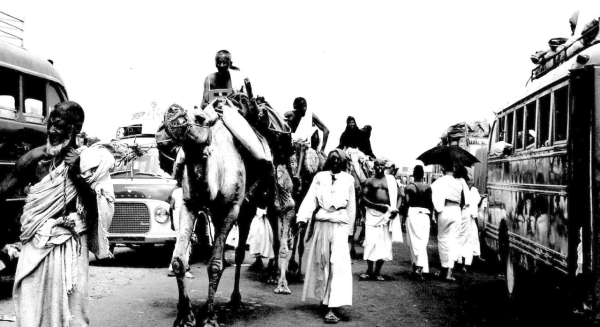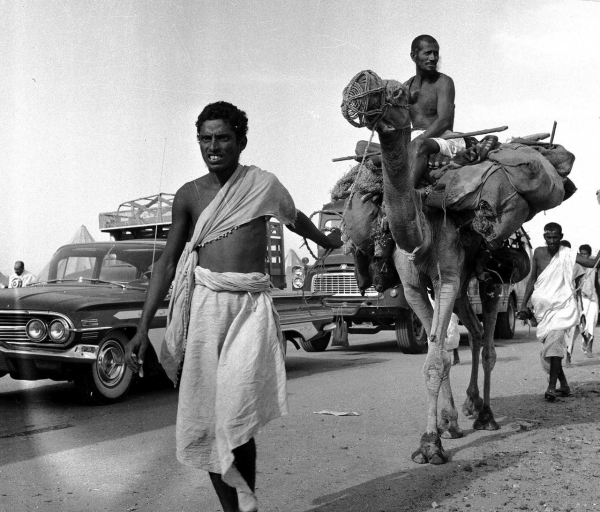


Historical hajj routes refer to a transportation network that leads to the Two Holy Mosques in Makkah al-Mukarramah and al-Madinah al-Munawwarah both by land and sea, from all over the world, for performing hajj rites or visiting purposes. Since Islam's advent, these routes have been marked by specific flags and tracks. For fourteen centuries, they remained in use by pilgrims until the establishment of modern transportation means.
These routes were originally used by trade caravans. However, with Islam, they were transformed into roads to transport pilgrims. They are divided into four comprehensive routes depending on the place and direction of each, as follows: The Egyptian Road, the Levantine Road, The Iraqi Road known as Darb Zubayda, and the Yemeni Road.
In the old days, these routes were supervised by caliphs, ministers, and good-doers. Stations, resting places, and irrigation facilities, such as wells and springs, were constructed along these roads. These routes located within Saudi Arabia are classified as archaeological sites. The Ministry of Tourism supervises the rehabilitation of these roads and the preparation of their stations.
Cultural role of historical Hajj routes
This network was historically established by the Arab and Islamic cultural foundations. In addition to their religious purpose, hajj routes were used for trading, making them a center of economic, cultural, political, and religious interactions in the areas stretching along those routes. Cities and metropolitan areas were constructed along these roads with economic and structural aspects. They include Jeddah, Athar (in Jazan), Bahrain, Ta'z, al-Yamama, and Sana'a.
The hajj and trade routes attracted travelers and explorers to the Arabian Peninsula. The historical route network appeared graphically for the first time in the sixteenth century in "The Map of The Three Arabias" by French geographical scientist Nicolas Sanson. It was a call for exploration and travel, as he clarified the hajj stages to Makkah al-Mukarramah. Due to Makkah al-Mukarramah and al-Madinah al-Munawwarah's holy character, only Muslims can enter these cities. Motivated by curiosity, some travelers have converted to Islam to reach the end of the road and complete the hajj route.
The route on which Prophet Muhammed peace be upon him (PBUH) and his Companions moved when he captured Makkah in the year 629 was the first route to the Grand Mosque between al-Madinah al-Munawwarah and Makkah al-Mukarramah in the Islamic era. Due to the expansion of the Islamic land, the expansion of the hajj and trade routes network was deemed necessary.
Key historic hajj routes
Kufa Road, known as Darb Zubayda, is the most famous hajj route. Islamic armies took this route for the first time to Iraq under the leadership of the Prophet's companion, Saad Ibn Abi Waqqas. It became a route for pilgrims from Iraq to Makkah al-Mukarramah. It gained political and economic significance since it was the main route linking the Islamic Caliphate headquarters in Baghdad and the Two Holy Mosques. This route is home to historical sites, including Ain Zubaida. Historical towns developed along this route, including Zubala, Thalabiya, and al-Rabatha. It starts within the Saudi borders from Aqaba station to Makkah al-Mukarramah in the north.
The Basra-Makkah al-Mukarramah Road starts from the city of Basra, passing by the northeast of the Arabian Peninsula through Wadi al-Batin, crossing several desert areas, the most difficult of which is the Dahana Desert. Then, it passes through al-Qassim Province, after which the road runs parallel to the Kufa-Makkah al-Mukarramah Road, until both routes meet at Umm Khurman or Awtas Station, which is located ten m from Dhat 'Irq. The Basra Road meets the main road extending from Kufa at al-Nuqra area, from which a road branches off to al-Madinah al-Munawwarah.
The road stretches about 1,520 km and includes twenty-seven main stations, including four stations currently located within the Iraqi-Kuwaiti borders. The other stations are located within the territories of Saudi Arabia.
Laventine Hajj Road
The Laventine Hajj Route stretches to Makkah al-Mukarramah from Halat Ammar Border, north of Saudi Arabia. It passes through Tabuk and al-Madinah al-Munawwarah to eventually reach Makkah al-Mukarramah. Al-Ula was the main station on this route, as it contains the most significant three archaeological sites: Khuraybah, Hegra, and al-Ma'abiyat.
Egyptian Hajj Road
Egyptian pilgrims used to take the Egyptian Hajj Road, which has two tracks: land and sea. The land track is divided into an internal one and another on the Red Sea coast. The Egyptian Road was famous for its Islamic sites dating to the early Islamic period. The most important are the seven wells in Wadi Diba'a, Khan al-Usharayh in Yanbu, and Badr mosques.
Yemeni Upper Hajj Road
Pilgrims from the south of the Arabian Peninsula used to travel through the Yemeni Upper Hajj Road. This route includes land and sea tracks via several seaports, including al-Sereen, al-Laith, and Jeddah. The land tracks diverge into several roads due to trading between Yemen and the north of the Arabian Peninsula. One of these roads dates back one thousand years BC, when Balkis, Queen of Sheba, visited Prophet Sulaiman in the Levant, as the Holy Quran mentions.
Omani Hajj Road
The Omani Hajj Road links the southeastern Arabian Peninsula with the Two Holy Mosques. It branches into two tracks: one stretches to the north along the eastern coast of Saudi Arabia before turning west to al-Yamama, then to Dariyyah Governorate, a meeting point for al-Basrah and Bahrain pilgrims. The other track is the route that stretches towards Faraq, then to Dhofar, west of Oman.
Related quizzes
Related articles
